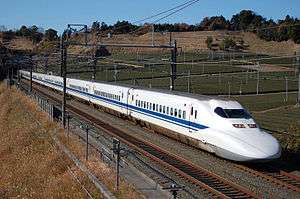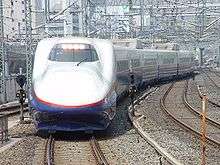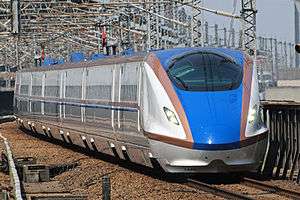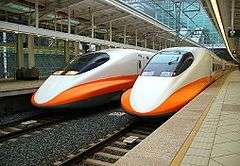WIN350
| 500-900 series "WIN350" | |
|---|---|
|
End car 500-906 preserved at Hakata Shinkansen Depot, October 2011 | |
| In service | 1992–1995 |
| Manufacturer | Hitachi, Kawasaki Heavy Industries |
| Constructed | 1992 |
| Scrapped | 1996 |
| Number built | 6 vehicles |
| Number in service | None |
| Number preserved | 2 vehicles |
| Number scrapped | 4 vehicles |
| Formation | 6 cars |
| Fleet numbers | W0 |
| Operator(s) | JR West |
| Depot(s) | Hakata |
| Line(s) served | Sanyo Shinkansen |
| Specifications | |
| Car body construction | Aluminium alloy |
| Car length |
26,550 mm (87 ft 1 in) (end cars), 25,000 mm (82 ft 0 in) (intermediate cars)[1] |
| Width | 3,380 mm (11 ft 1 in) |
| Maximum speed | 350 km/h (215 mph) (nominal)[1] |
| Traction system | 300 kW (400 hp) 3-phase motors |
| Electric system(s) | 25 kV AC, 60 Hz |
| Current collection method | Overhead catenary |
| Safety system(s) | ATC |
| Track gauge | 1,435 mm (4 ft 8 1⁄2 in) |
"WIN350" was the name given to the 500-900 series (500系900番代) 6-car experimental high-speed Shinkansen train developed in 1992 by the West Japan Railway Company (JR West) in Japan to test technology to be incorporated in next-generation shinkansen trains expected to operate at speeds of 350 km/h (217 mph) from 1994.[2] Initially given the designation "500X", the name "WIN350" stood for "West Japan's Innovation for operation at 350 km/h".[3]
Design
Cars 500-901 to 500-903 were built by Kawasaki Heavy Industries in Hyogo Prefecture. Cars 500-904 to 500-906 were built by Hitachi in Yamaguchi Prefecture.[4]
The front-end designs of the two driving vehicles (500-901 and 500-906) were slightly different, with 500-906 featuring a "cockpit" style arrangement.[3] The external livery was purple and light grey, with darker purple lining.
All axles were motored, using 300 kW three-phase motors, and cars were equipped with tilting and active suspension.[3]
Internally, only car 4 was fitted with passenger seats, with 10 rows of 3+2 standard-class seating and 5 rows of 2+2 Green class (first class) seating.[5]
Formation
The 6-car set, designated "W0", was formed as follows.[6]
| Car No. | 1 | 2 | 3 | 4 | 5 | 6 |
|---|---|---|---|---|---|---|
| Designation | M'1c | M'1p | M1 | M2 | M'2p | M2c |
| Numbering | 500-901 | 500-902 | 500-903 | 500-904 | 500-905 | 500-906 |
Initially, cars 1, 2, and 5 were fitted with pantographs.[5]
History
The WIN350 train was delivered to Hakata Shinkansen Depot in April 1992.[4]
On 6 August 1992, the train recorded a Japanese national speed record of 345.8 km/h on the Sanyo Shinkansen.[3] Two days later, on 8 August 1992, the train recorded a Japanese national speed record of 350.4 km/h on the Sanyo Shinkansen between Ogōri (now Shin-Yamaguchi) and Shin-Shimonoseki.[2]
The WIN350 trainset was withdrawn on 31 May 1996, and a special farewell ceremony was held at Hakata Shinkansen Depot.[2][3]
Preservation
.jpg)
End car 500-901 is preserved outdoors at the RTRI large-scale wind tunnel test facility in Maibara, Shiga. Initially expected to be moved to the Modern Transportation Museum in Osaka,[3] car 500-906 is preserved at Hakata Shinkansen Depot.[7]
References
- 1 2 JR全車輛ハンドブック'93 [JR Rolling Stock Handbook 1993]. Japan: Neko Publishing. 1993.
- 1 2 3 プロトタイプの世界 - Prototype World. Japan: Kōtsū Shimbunsha. December 2005. pp. 56–59. OCLC 170056962.
- 1 2 3 4 5 6 Semmens, Peter (1997). High Speed in Japan: Shinkansen - The World's Busiest High-speed Railway. Sheffield, UK: Platform 5 Publishing. ISBN 1-872524-88-5.
- 1 2 "500系新幹線電車" [500 series Shinkansen EMU]. Japan Railfan Magazine. Vol. 32 no. 374. Japan: Kōyūsha. June 1992. pp. 18–19.
- 1 2 "500系新幹線試験電車" [500 series Experimental Shinkansen EMU]. Japan Railfan Magazine. Vol. 32 no. 375. Japan: Koyusha. July 1992. pp. 52–58.
- ↑ 新幹線電車データブック2011 [Shinkansen Databook 2011]. Japan: JRR. March 2011. p. 95. ISBN 978-4-330-19811-8.
- ↑ 鉄道のテクノロジーVol1:新幹線 [Railway Technology Vol.1: Shinkansen]. Japan: Sanei Mook. April 2009. pp. 122–124. ISBN 978-4-7796-0534-5.
External links
![]() Media related to 500-900 series "WIN350" at Wikimedia Commons
Media related to 500-900 series "WIN350" at Wikimedia Commons
.jpg)



